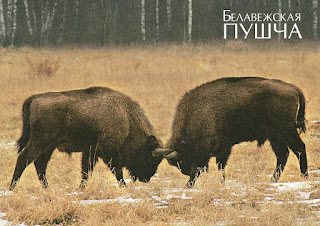This is probably the most wonderful forest in Europe!
 |
| Fauna of Białowieża Forest |
This postcard showing an European bison, two grey wolves, a lynx, a red fox and a raccoon dog was sent by Boguslaw
The Białowieża Forest World Heritage site, on the border between Poland and Belarus, is an immense range of primary forest including both conifers and broadleaved trees covering a total area of 141,885 hectares. Situated on the watershed of the Baltic Sea and Black Sea, this transboundary property is exceptional for the opportunities it offers for biodiversity conservation. It is home to the largest population of the property’s iconic species, the European bison. - in: http://whc.unesco.org/en/list/33
 |
| Birds of Białowieża Forest |
This postcard showing a raven, two Eurasian eagle-owls, a common buzzard, a common crane, a white tailed eagle and two black storks was sent by Ania
The property protects a diverse and rich wildlife of which 59 mammal species, over 250 bird, 13 amphibian, 7 reptile and over 12,000 invertebrate species. The iconic symbol of the property is the European Bison: approximately 900 individuals in the whole property which make almost 25% of the total world’s population and over 30% of free-living animals. - in: http://whc.unesco.org/en/list/33
 |
| European Bison in the Białowieża Forest |
This postcard was sent by Tanya
The European bison (Bison bonasus), also known as wisent or the European wood bison, is a Eurasian species of bison. It is one of two extant species of bison, alongside the American bison. Three subspecies have existed in the past, but only one survives today.
The European bison is the heaviest surviving wild land animal in Europe. - in: wikipedia
 |
| Common Buzzard in the Białowieża Forest |
This postcard was sent by Igor
The common buzzard (Buteo buteo) is a medium-to-large bird of prey whose range covers most of Europe and extends into Asia. Over much of its range, it is resident year-round, but birds from the colder parts of the northern hemisphere typically migrate south (some well into the southern hemisphere) for the northern winter. - in: wikipedia
 |
| European Pine Marten in the Białowieża Forest |
This postcard was sent by Tanya
The European pine marten (Martes martes), known most commonly as the pine marten in Anglophone Europe, and less commonly also known as pineten, baum marten, or sweet marten, is an animal native to Northern Europe belonging to the mustelid family, which also includes mink, otter, badger, wolverine and weasel. It is about the size of a domestic cat.
Their habitats are usually well-wooded areas. European pine martens usually make their own dens in hollow trees or scrub-covered fields. Martens are the only mustelids with semi-retractable claws. This enables them to lead more arboreal lifestyles, such as climbing or running on tree branches, although they are also relatively quick runners on the ground. - in: wikipedia
 |
| Wild Boar in the Białowieża Forest |
This postcard was sent by Tanya
The wild boar (Sus scrofa), also known as the wild swine or Eurasian wild pig is a suid native to much of Eurasia, North Africa, and the Greater Sunda Islands. Human intervention has spread its range further, making the species one of the widest-ranging mammals in the world, as well as the most widely spread suiform. Its wide range, high numbers, and adaptability mean that it is classed as least concern by the IUCN. The animal probably originated in Southeast Asia during the Early Pleistocene, and outcompeted other suid species as it spread throughout the Old World. - in: wikipedia
 |
| Raccoon Dog in the Białowieża Forest |
This postcard was sent by Tanya
The raccoon dog (Nyctereutes procyonoides), also known as the mangut or tanuki, is a canid indigenous to East Asia. It is the only extant species in the genus Nyctereutes. It is considered a basal canid species, resembling ancestral forms of the family. - in: wikipedia
 |
| Roe Deer in the Białowieża Forest |
This postcard was sent by Tanya
The European roe deer (Capreolus capreolus), also known as the western roe deer, chevreuil, or roe deer, is a Eurasian species of deer. The male of the species is sometimes referred to as a roebuck. The roe deer is relatively small, reddish and grey-brown, and well-adapted to cold environments. The species is widespread in Europe, from the Mediterranean to Scandinavia and from Britain to the Caucasus. It is distinct from the somewhat larger Siberian roe deer. - in: wikipedia
 |
| Moose in the Białowieża Forest |
This postcard was sent by Tanya
The moose (North America) or elk (Eurasia), Alces alces, is the largest extant species in the deer family. Moose are distinguished by the palmate antlers of the males; other members of the family have antlers with a dendritic ("twig-like") configuration. Moose typically inhabit boreal and mixed deciduous forests of the Northern Hemisphere in temperate to subarctic climates. Moose used to have a much wider range but hunting and other human activities have greatly reduced it. Moose have been reintroduced to some of their former habitats.
In Europe, moose are currently found in large numbers throughout Norway, Sweden, Finland, Latvia, Estonia, Poland, with more modest numbers in the southern Czech Republic, Belarus and northern Ukraine. - in: wikipedia


No comments:
Post a Comment